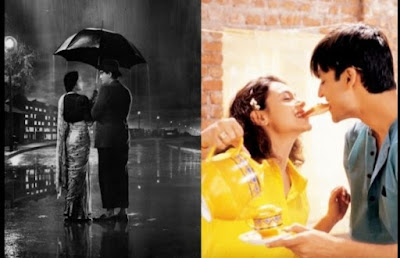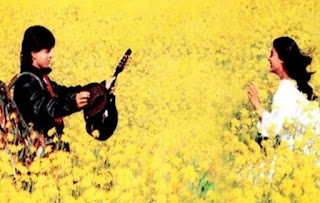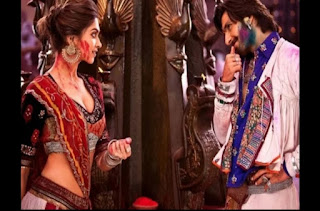From the black and white era of Shree 420 (1955) and Pyaasa (1957) to today's OTT original stories, the representation of love and relationships has changed dramatically. Writers and directors have quickly identified the changing trend among lovers, from the time of love letters to the time of dating apps.
The sensitive, melodramatic love (1950s-1970s)
These decades produced nearly 219 films that began to explore love in a traditional and highly emotional manner. With stories like Shree 420, Pyaasa, Hulchul, Chalti Ka Naam Gaadi, Sadhna, and Nadiya Ke Paar, the stories and relationships centred on the ideal, acceptable romance, where the villain was not a person but circumstances. It reflected on the larger picture of reality, in which a man and a woman in matrimony or a deep commitment face the curveballs that life throws at them. The protagonists' unity was aspirational, giving the audience a sense of longing for such a strong and united alliance. This was also an important period in Indian cinema because it was transitioning from black and white to colour movies. As a result, filmmakers were now required to incorporate visual aesthetics into their scenes in order to convey emotion onscreen. These two decades also gave Indian cinema iconic films like Mughal-E-Azam, Devdas, Sahib Bibi Aur Ghulam, and Guide.
The second half of the 1960s saw an increase in creativity. Instead of simply introducing a couple in love and adversity in their lives, stories like Jewel Thief, Sahib Bibi Aur Ghulam, Sangam, Guide, Ram Aur Shyam, and Khilona began to explore the complexities of relationships and the various possibilities that can occur in the lives of two people in love. For example, a love triangle, mistrust in a married couple, love between an unlikely couple, and so on began to form the foundations of relationships. All of this titillates the audience's minds without causing any controversy. Bobby, starring Rishi Kapoor and Dimple Kapadia in 1973, was considered far too daring for the young audience at the time, and the streak of rebellion introduced in love stories later became a paradigm for films to come.
The obstinate, enraged love
The'modern era of love' was the window of the 1980s. Girls were wearing stylish scarves, pants, big sunglasses, and puffed hairdos to college, while the boys were brash, dare devilish, and very, very angry for some reason. Surprisingly, this is also possibly the only decade in which writers and directors experimented with various shades of love. On the one hand, there were films such as Tezaab, Hero, Prem Rog, Qayamat Se Qayamat Tak, Rocky, and many others in which the central theme of intense, passionate love encouraged the protagonists to flee, take drastic measures, and fight for their love and unite by hook or by crook.On the other hand, there were films like Shehenshaah, Sharaabi, Coolie, Himmatwala, and Satte Pe Satta, in which the driving force was a love storey, but the loud action, macho image, and hard-hitting dialogues of the hero overshadowed the soft intensity of the love storey. Then, every now and then, there were stories like Sadma and Silsila, which gave the audience a break from watching love in its purest form. In the midst of action-oriented loud punches, whistle-generating, in-your-face, blood-boiling dialogues, films like these came as a breath of fresh air to an audience that craved to simply indulge in their romantic fantasies. Maine Pyar Kiya, starring Salman Khan and Bhagyashree, was released in 1989, near the end of the decade. The success of this film, like that of Bobby, foreshadowed what the next decade in Bollywood would bring.
The 1990s were the era of Shah Rukh Khan and the celebration of young love.
This was possibly the most interesting and exciting period for new age moviegoers. Bollywood produced some of the most iconic love stories of all time during the 1990s. Many films also included the entire college romance sequence in the frame, which drew a lot of attention from college students. Bollywood got Shah Rukh Khan, and fans got a one-way ticket to a fantasy world where the definition of love and relationships was flipped on its head.It's worth noting that the basic premise of a love storey hasn't changed much over the years. A hero, a heroine, and a villain, but now Bollywood was daring to go global. Dreamy sequences, new shooting locations, and bigger and better song and dance sequences. It's safe to say that the amount of money pumped into film production was higher than ever, allowing directors to add fanfare around romance and feed aspirational stories to the audience.This era witnessed Shah Rukh Khan and Kajol's timeless love in the 1995 release Dilwale Dulhania Le Jayenge, which remains a box office success to this day. Hum Aapke Hain Koun gave moviegoers a taste of Sooraj Barjatiya's family drama and the love between Prem and Nisha. It also brought about the craziness of love between Baazigar and Darr. This era featured numerous love stories and relationships that were popular among India's young adults. Some of the biggest blockbusters that celebrated young love were Saajan, Rangeela, Bombay, Kabhi Haan Kabhi Naa, and Kuch Kuch Hota Hai.
In the year 2000, love becomes a reality
The audience had begun to lose interest in the overly sensationalised stories by this point. The genre of alternate cinema had begun to emerge, and audiences appeared to be emerging from the dreamy, unreal ways of storytelling. This is also a period when the treatment of love stories was changing. It wasn't just about an actor, an actress, and a villain.While films like Dil Chahta Hai and Kal Ho Naa Ho gave that feel-good feeling, writers began to explore the complexities of relationships, of the married couple, of lovers separated during Partition, of teenage pregnancy, and other such issues in Mohabbatein. It wasn't just about sugary love any longer. Films like Kabhi Alvida Naa Kehna, Gadar, Saathiya, Veer-Zaara, Salaam Namastey, and Rab Ne Bana Di Jodi, among others, were now focusing on bringing love stories that were not only about romance, but also about the individuality of the people in love.This type of narrative resonated well with the young, tech-driven, ambitious Indian who desired love but had also begun to seek their identity. The relationships in these films were no longer co-dependent on one another in order to achieve ultimate happiness.









